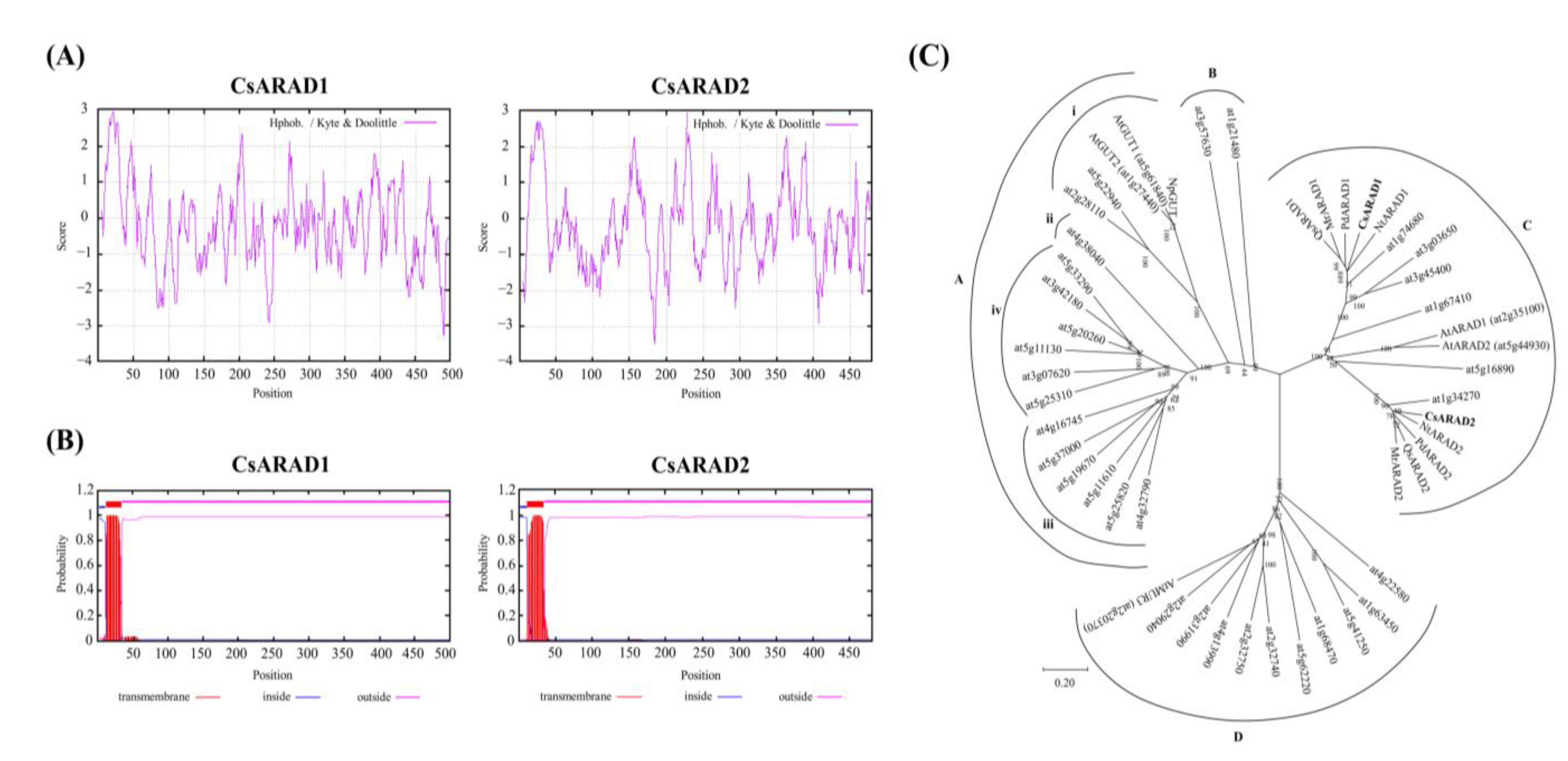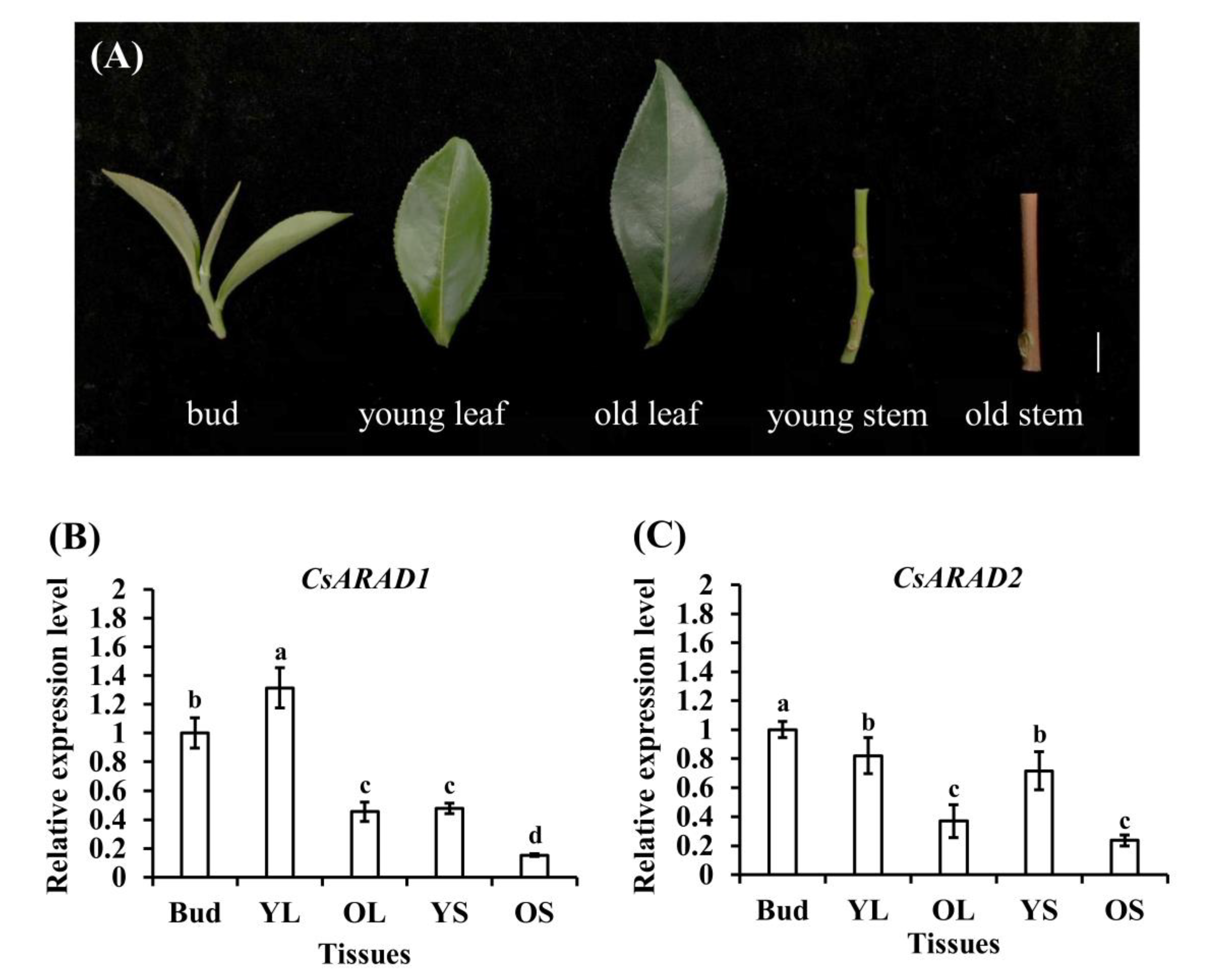Isolation and Molecular Characterization of Two Arabinosyltransferases in Response to Abiotic Stresses in Sijichun Tea Plants (Camellia sinensis L.)
Abstract
1. Introduction
2. Materials and Methods
2.1. Plant Materials
2.2. Cloning and Rapid Amplification of cDNA Ends
2.3. Bioinformatics Analysis of CsARAD Gene
2.4. Abiotic Stress and Hormone Treatments on Tea Seedlings
2.5. Total RNA Extraction and qRT-PCR
2.6. Statistics
3. Results
3.1. Bioinformatics Analysis of CsARAD Gene and Amino Acid Sequences of C. sinenesis L.
3.2. High Level of CsARAD Expression in Nonlignified Tissues of Tea Plants
3.3. Transcript Level of CsARADs Was Affected by Environmental Factors and Hormonal Signals
3.4. Abiotic Stresses and Hormonal Signals Regulate CsARAD Expression
4. Discussion
5. Conclusions
Supplementary Materials
Author Contributions
Funding
Data Availability Statement
Conflicts of Interest
References
- Zhang, L.; Ho, C.T.; Zhou, J.; Santos, J.S.; Armstrong, L.; Granato, D. Chemistry and biological activities of processed Camellia sinensis teas: A comprehensive review. Compr. Rev. Food Sci. Food Saf. 2019, 18, 1474–1495. [Google Scholar] [CrossRef] [PubMed]
- Bai, W.-X.; Wang, C.; Wang, Y.-J.; Zheng, W.-J.; Wang, W.; Wan, X.-C.; Bao, G.-H. Novel acylated flavonol tetraglycoside with inhibitory effect on lipid accumulation in 3T3-L1 cells from Lu’an GuaPian tea and quantification of flavonoid glycosides in six major processing types of tea. J. Agric. Food Chem. 2017, 65, 2999–3005. [Google Scholar] [CrossRef] [PubMed]
- Jiang, L.; Shen, X.; Shoji, T.; Kanda, T.; Zhou, J.; Zhao, L. Characterization and activity of anthocyanins in Zijuan tea (Camellia sinensis var. kitamura). J. Agric. Food Chem. 2013, 61, 3306–3310. [Google Scholar] [CrossRef] [PubMed]
- Louveau, T.; Orme, A.; Pfalzgraf, H.; Stephenson, M.J.; Melton, R.; Saalbach, G.; Hemmings, A.M.; Leveau, A.; Rejzek, M.; Vickerstaff, R.J. Analysis of two new arabinosyltransferases belonging to the carbohydrate-active enzyme (CAZY) glycosyl transferase family1 provides insights into disease resistance and sugar donor specificity. Plant Cell 2018, 30, 3038–3057. [Google Scholar] [CrossRef] [PubMed]
- Gachon, C.M.; Langlois-Meurinne, M.; Saindrenan, P. Plant secondary metabolism glycosyltransferases: The emerging functional analysis. Trends Plant Sci. 2005, 10, 542–549. [Google Scholar] [CrossRef]
- Yan, J.; Fang, L.; Yang, L.; He, H.; Huang, Y.; Liu, Y.; Zhang, A. Abscisic acid positively regulates l-arabinose metabolism to inhibit seed germination through ABSCISIC ACID INSENSITIVE4-mediated transcriptional promotions of MUR4 in Arabidopsis thaliana. New Phytol. 2020, 225, 823–834. [Google Scholar] [CrossRef]
- Hansen, S.F.; Harholt, J.; Oikawa, A.; Scheller, H.V. Plant glycosyltransferases beyond CAZy: A perspective on DUF families. Front. Plant Sci. 2012, 3, 59. [Google Scholar] [CrossRef]
- Wu, A.; Hao, P.; Wei, H.; Sun, H.; Cheng, S.; Chen, P.; Ma, Q.; Gu, L.; Zhang, M.; Wang, H. Genome-wide identification and characterization of glycosyltransferase family 47 in cotton. Front. Genet. 2019, 10, 824. [Google Scholar] [CrossRef]
- Ma, Y.; Ding, S.; Fei, Y.; Liu, G.; Jang, H.; Fang, J. Antimicrobial activity of anthocyanins and catechins against foodborne pathogens Escherichia coli and Salmonella. Food Control 2019, 106, 106712. [Google Scholar] [CrossRef]
- Porchia, A.C.; Sørensen, S.O.; Scheller, H.V. Arabinoxylan biosynthesis in wheat. Characterization of arabinosyltransferase activity in Golgi membranes. Plant Physiol. 2002, 130, 432–441. [Google Scholar] [CrossRef]
- Geshi, N.; Harholt, J.; Sakuragi, Y.; Jensen, J.K.; Scheller, H.V. Glycosyltransferases of the GT47 family. Annu. Plant Rev. Plant Polysacch. Biosynth. Bioeng. 2010, 41, 265–283. [Google Scholar]
- Zhong, R.; Ye, Z.-H. Unraveling the functions of glycosyltransferase family 47 in plants. Trends Plant Sci. 2003, 8, 565–568. [Google Scholar] [CrossRef] [PubMed]
- Harholt, J.; Jensen, J.K.; Verhertbruggen, Y.; Søgaard, C.; Bernard, S.; Nafisi, M.; Poulsen, C.P.; Geshi, N.; Sakuragi, Y.; Driouich, A. ARAD proteins associated with pectic Arabinan biosynthesis form complexes when transiently overexpressed in planta. Planta 2012, 236, 115–128. [Google Scholar] [CrossRef] [PubMed]
- Verhertbruggen, Y.; Marcus, S.E.; Chen, J.; Knox, J.P. Cell wall pectic arabinans influence the mechanical properties of Arabidopsis thaliana inflorescence stems and their response to mechanical stress. Plant Cell Physiol. 2013, 54, 1278–1288. [Google Scholar] [CrossRef] [PubMed]
- Petersen, B.L.; MacAlister, C.A.; Ulvskov, P. Plant protein O-arabinosylation. Front. Plant Sci. 2021, 12, 645219. [Google Scholar] [CrossRef]
- Zhang, L.; Zhao, Y.; Gao, Y.; Wu, L.; Gao, R.; Zhang, Q.; Wang, Y.; Wu, C.; Wu, F.; Gurcha, S.S. Structures of cell wall arabinosyltransferases with the anti-tuberculosis drug ethambutol. Science 2020, 368, 1211–1219. [Google Scholar] [CrossRef]
- Harholt, J.; Jensen, J.K.; Sørensen, S.O.; Orfila, C.; Pauly, M.; Scheller, H.V. Arabinan deficient 1 is a putative arabinosyltransferase involved in biosynthesis of pectic arabinan in Arabidopsis. Plant Physiol. 2006, 140, 49–58. [Google Scholar] [CrossRef]
- Ahmed, S.; Griffin, T.S.; Kraner, D.; Schaffner, M.K.; Sharma, D.; Hazel, M.; Leitch, A.R.; Orians, C.M.; Han, W.; Stepp, J.R. Environmental factors variably impact tea secondary metabolites in the context of climate change. Front. Plant Sci. 2019, 10, 939. [Google Scholar] [CrossRef]
- Iwai, H.; Masaoka, N.; Ishii, T.; Satoh, S. A pectin glucuronyltransferase gene is essential for intercellular attachment in the plant meristem. Proc. Natl. Acad. Sci. USA 2002, 99, 16319–16324. [Google Scholar] [CrossRef]
- Saulnier, L.; Guillon, F.; Chateigner-Boutin, A.-L. Cell wall deposition and metabolism in wheat grain. J. Cereal Sci. 2012, 56, 91–108. [Google Scholar] [CrossRef]
- Zhou, G.-K.; Zhong, R.; Richardson, E.A.; Morrison, W.H., III; Nairn, C.J.; Wood-Jones, A.; Ye, Z.-H. The poplar glycosyltransferase GT47C is functionally conserved with Arabidopsis Fragile fiber8. Plant Cell Physiol. 2006, 47, 1229–1240. [Google Scholar] [CrossRef]
- Wilmowicz, E.; Kućko, A.; Alché, J.D.D.; Czeszewska-Rosiak, G.; Florkiewicz, A.B.; Kapusta, M.; Karwaszewski, J. Remodeling of Cell Wall Components in Root Nodules and Flower Abscission Zone under Drought in Yellow Lupine. Int. J. Mol. Sci. 2022, 23, 1680. [Google Scholar] [CrossRef] [PubMed]
- Zhang, B.; Gao, Y.; Zhang, L.; Zhou, Y. The plant cell wall: Biosynthesis, construction, and functions. J. Integr. Plant Biol. 2021, 63, 251–272. [Google Scholar] [CrossRef] [PubMed]
- Barajas-Lopez, J.d.D.; Tiwari, A.; Zarza, X.; Shaw, M.W.; Pascual, J.; Punkkinen, M.; Bakowska, J.C.; Munnik, T.; Fujii, H. Early response to dehydration 7 Remodels Cell Membrane Lipid Composition during Cold Stress in Arabidopsis. Plant Cell Physiol. 2020, 62, 80–91. [Google Scholar] [CrossRef] [PubMed]
- Ganie, S.A.; Ahammed, G.J. Dynamics of cell wall structure and related genomic resources for drought tolerance in rice. Plant Cell Rep. 2021, 40, 437–459. [Google Scholar] [CrossRef]
- Mariette, A.; Kang, H.S.; Heazlewood, J.L.; Persson, S.; Ebert, B.; Lampugnani, E.R. Not Just a Simple Sugar: Arabinose Metabolism and Function in Plants. Plant Cell Physiol. 2021, 62, 1791–1812. [Google Scholar] [CrossRef]
- Hura, T.; Hura, K.; Ostrowska, A. Drought-Stress Induced Physiological and Molecular Changes in Plants. Int. J. Mol. Sci. 2022, 23, 4698. [Google Scholar] [CrossRef]
- Carroll, S.; Amsbury, S.; Durney, C.H.; Smith, R.S.; Morris, R.J.; Gray, J.E.; Fleming, A.J. Altering arabinans increases Arabidopsis guard cell flexibility and stomatal opening. Curr. Biol. 2022, 32, 3170–3179.e4. [Google Scholar] [CrossRef]
- Aksamit-Stachurska, A.; Korobczak-Sosna, A.; Kulma, A.; Szopa, J. Glycosyltransferase efficiently controls phenylpropanoid pathway. BMC Biotechnol. 2008, 8, 25. [Google Scholar] [CrossRef]
- Blanco-Ulate, B.; Vincenti, E.; Powell, A.L.; Cantu, D. Tomato transcriptome and mutant analyses suggest a role for plant stress hormones in the interaction between fruit and Botrytis cinerea. Front. Plant Sci. 2013, 4, 142. [Google Scholar] [CrossRef]
- Jeong, S.-W.; Das, P.K.; Jeoung, S.C.; Song, J.-Y.; Lee, H.K.; Kim, Y.-K.; Kim, W.J.; Park, Y.I.; Yoo, S.-D.; Choi, S.-B. Ethylene suppression of sugar-induced anthocyanin pigmentation in Arabidopsis. Plant Physiol. 2010, 154, 1514–1531. [Google Scholar] [CrossRef] [PubMed]
- Xu, Z.-J.; Nakajima, M.; Suzuki, Y.; Yamaguchi, I. Cloning and Characterization of the Abscisic Acid-Specific Glucosyltransferase Gene from Adzuki Bean Seedlings. Plant Physiol. 2002, 129, 1285–1295. [Google Scholar] [CrossRef] [PubMed]
- Ma, Q.; Su, C.; Dong, C.-H. Genome-Wide Transcriptomic and Proteomic Exploration of Molecular Regulations in Quinoa Responses to Ethylene and Salt Stress. Plants 2021, 10, 2281. [Google Scholar] [CrossRef] [PubMed]
- Moya-León, M.A.; Mattus-Araya, E.; Herrera, R. Molecular events occurring during softening of strawberry fruit. Front. Plant Sci. 2019, 10, 615. [Google Scholar] [CrossRef]





| Protein | CsARAD1 (57.07 kDa) | CsARAD2 (54.23 kDa) | |
|---|---|---|---|
| Amino Acid | |||
| Alanine (A) | 6.2% | 5.0% | |
| Araginine (R) | 6.2% | 5.8% | |
| Asparagine (N) | 4.8% | 4.2% | |
| Asparate (D) | 5.4% | 5.4% | |
| Cysteine (C) | 1.2% | 1.5% | |
| Glutamin (Q) | 4.2% | 3.3% | |
| Glutamate (E) | 4.6% | 5.2% | |
| Glycine (G) | 5.2% | 5.8% | |
| Histidine (H) | 3.0% | 2.7% | |
| Isoleucine (I) | 6.4% | 5.4% | |
| Leucine (L) | 10.4% | 10.6% | |
| Lysine (K) | 6.0% | 5.6% | |
| Methionine (M) | 2.4% | 1.9% | |
| Phenylalainie (F) | 5.6% | 4.8% | |
| Proline (P) | 5.0% | 6.5% | |
| Serine (S) | 9.6% | 9.4% | |
| Threonine (T) | 2.4% | 4.6% | |
| Tryptophan (W) | 1.4% | 1.9% | |
| Tyrosine (Y) | 3.8% | 3.1% | |
| Valine (V) | 6.2% | 7.3% | |
| Pyrrolysine (O) | 0.0% | 0.0% | |
| Selenocysteine (U) | 0.0% | 0.0% | |
Disclaimer/Publisher’s Note: The statements, opinions and data contained in all publications are solely those of the individual author(s) and contributor(s) and not of MDPI and/or the editor(s). MDPI and/or the editor(s) disclaim responsibility for any injury to people or property resulting from any ideas, methods, instructions or products referred to in the content. |
© 2023 by the authors. Licensee MDPI, Basel, Switzerland. This article is an open access article distributed under the terms and conditions of the Creative Commons Attribution (CC BY) license (https://creativecommons.org/licenses/by/4.0/).
Share and Cite
Liao, T.-C.; Chen, C.-T.; Wang, M.-C.; Ou, S.-L.; Tzen, J.T.C.; Yang, C.-Y. Isolation and Molecular Characterization of Two Arabinosyltransferases in Response to Abiotic Stresses in Sijichun Tea Plants (Camellia sinensis L.). Agronomy 2023, 13, 1476. https://doi.org/10.3390/agronomy13061476
Liao T-C, Chen C-T, Wang M-C, Ou S-L, Tzen JTC, Yang C-Y. Isolation and Molecular Characterization of Two Arabinosyltransferases in Response to Abiotic Stresses in Sijichun Tea Plants (Camellia sinensis L.). Agronomy. 2023; 13(6):1476. https://doi.org/10.3390/agronomy13061476
Chicago/Turabian StyleLiao, Tzu-Chiao, Chung-Tse Chen, Mao-Chang Wang, Shang-Ling Ou, Jason T. C. Tzen, and Chin-Ying Yang. 2023. "Isolation and Molecular Characterization of Two Arabinosyltransferases in Response to Abiotic Stresses in Sijichun Tea Plants (Camellia sinensis L.)" Agronomy 13, no. 6: 1476. https://doi.org/10.3390/agronomy13061476
APA StyleLiao, T.-C., Chen, C.-T., Wang, M.-C., Ou, S.-L., Tzen, J. T. C., & Yang, C.-Y. (2023). Isolation and Molecular Characterization of Two Arabinosyltransferases in Response to Abiotic Stresses in Sijichun Tea Plants (Camellia sinensis L.). Agronomy, 13(6), 1476. https://doi.org/10.3390/agronomy13061476





